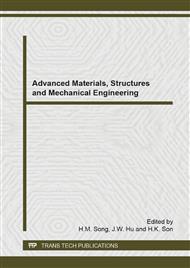[1]
B.F. Zhu: The fifth international symposium on roller compacted concrete dam, (2007), p.1.
Google Scholar
[2]
X. Zhang: The prevention and control technology Concrete structure crack, Chemical industry press, (2006).
Google Scholar
[3]
C. Xue: The research of mass concrete temperature stress during the construction, Beijing, Tsinghua University, master degree thesis, (2006), p.7.
Google Scholar
[4]
W.Q. Fu and S.F. Han: The prevention and control of concrete engineering crack, China railway publishing house, (2007).
Google Scholar
[5]
R. Zhang: The temperature stress simulation research and crack control measures of high arch dam, Wuhan, Wuhan University, master degree thesis, (2005), p.2.
Google Scholar
[6]
J.J. Ma, J.Y. Fu and T. Ren: Water and elect. Energy. Sci. Vol. 31, No. 11 (2013), p.100.
Google Scholar
[7]
B.J. Si, Z.G. Sun and Q.H. Ai: Indus. Const. Vol. 37, No. 1 (2007), p.87.
Google Scholar
[8]
T.G. Zhang: J. Yunnan hydropower Vol. 20, No. 5 (2004), p.60.
Google Scholar
[9]
X. Zhang: The prevention and control technology Concrete structure crack, Chemical industry press, (2006).
Google Scholar
[10]
W. Q. Fu and S.F. Han: Concrete engineering crack prevention and control, China railway publishing house, (2007).
Google Scholar
[11]
Y.M. Zhu, Z.Q. Xu and L.L. Zhang: J. Hongshui River Vol. 21, No. 3 (2002), p.45.
Google Scholar
[12]
S.Q. Lu: J. Concrete No. 2 (2001), p.30.
Google Scholar
[13]
S.Q. Li: The research of mass concrete anti-cracking technology, Tianjin, Tianjin University, master degree thesis, (2004), p.35.
Google Scholar
[14]
Q. Ren and S.Q. Huang: J. layered design of hydropower stations Vol. 7, No. 1 (1991), p.41.
Google Scholar
[15]
Z.X. Zhou: Simulation analysis of mass concrete temperature field, Hunan, Central South University, master degree thesis, (2011), p.38.
Google Scholar
[16]
H.W. Long and J. Zhang: J. hydroelectric power Vol. 28, No. 6 (2009), p.131.
Google Scholar
[17]
H.H. Long, G. Xiong, Y.N. Wang and Z.G. Zhao: J. urban road and bridge and flood control, No. 11 (2009), p.35.
Google Scholar
[18]
L. Chen, L.S. Li and H. Zhang: J. Yangtze River Vol. 37, No. 5 (2006), p.28.
Google Scholar


